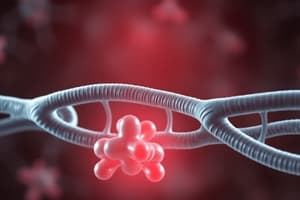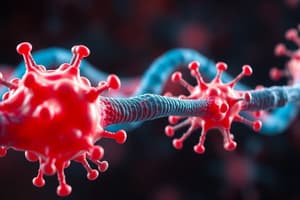Podcast
Questions and Answers
What is meant by 'full occupancy' in pharmacology?
What is meant by 'full occupancy' in pharmacology?
- Receptors can function even when not fully occupied by the drug.
- Maximum response occurs only when some receptors are free.
- The occupancy of receptors has no impact on drug efficacy.
- It requires that all receptors be occupied by the drug to achieve maximal response. (correct)
What does the law of mass action state about the interaction between a drug and its receptor?
What does the law of mass action state about the interaction between a drug and its receptor?
- The response is proportional to the drug concentration and the number of available receptors. (correct)
- The drug interacts with receptors regardless of their availability.
- The response is independent of the drug concentration.
- Maximum response occurs without receptor occupancy.
What is the significance of spare receptors in pharmacology?
What is the significance of spare receptors in pharmacology?
- They do not interact with drugs and are irrelevant to drug action.
- They allow a maximal response with lower drug concentrations when not all receptors need to be occupied. (correct)
- They offer additional binding sites for drugs, enhancing their effects.
- Their presence indicates that higher drug doses are required for full efficacy.
Which type of receptor requires drugs to cross the cell membrane for binding?
Which type of receptor requires drugs to cross the cell membrane for binding?
How do ligand-gated ion channels function upon drug binding?
How do ligand-gated ion channels function upon drug binding?
What characterizes intracellular receptors compared to other receptor types?
What characterizes intracellular receptors compared to other receptor types?
Which receptor is an example of a ligand-gated ion channel that allows chloride ions to pass through?
Which receptor is an example of a ligand-gated ion channel that allows chloride ions to pass through?
What is a key feature of the drug-receptor interaction in terms of concentration as indicated by the law of mass action?
What is a key feature of the drug-receptor interaction in terms of concentration as indicated by the law of mass action?
What structural characteristic defines G-protein coupled receptors (GPCRs)?
What structural characteristic defines G-protein coupled receptors (GPCRs)?
Which of the following statements best describes the selectivity of a drug?
Which of the following statements best describes the selectivity of a drug?
Which enzyme-linked receptor is specifically activated by insulin?
Which enzyme-linked receptor is specifically activated by insulin?
In the context of GPCRs, what effect does the beta-adrenergic receptor mediate?
In the context of GPCRs, what effect does the beta-adrenergic receptor mediate?
What does affinity indicate regarding drug-receptor interactions?
What does affinity indicate regarding drug-receptor interactions?
Which of the following is a common feature of approximately 50% of therapeutic drugs?
Which of the following is a common feature of approximately 50% of therapeutic drugs?
Which downstream effect occurs when a ligand binds to a G-protein coupled receptor?
Which downstream effect occurs when a ligand binds to a G-protein coupled receptor?
What is an example of a therapeutic drug target that exhibits high selectivity?
What is an example of a therapeutic drug target that exhibits high selectivity?
What does a high Therapeutic Index (TI) indicate about a drug?
What does a high Therapeutic Index (TI) indicate about a drug?
Which statement correctly defines the Therapeutic Index (TI)?
Which statement correctly defines the Therapeutic Index (TI)?
Why is warfarin considered to have a narrow therapeutic index?
Why is warfarin considered to have a narrow therapeutic index?
What is the structure of G-Protein Coupled Receptors (GPCRs)?
What is the structure of G-Protein Coupled Receptors (GPCRs)?
What is the role of the α subunit in G-proteins?
What is the role of the α subunit in G-proteins?
In terms of therapeutic index, which of the following pairs represents a safe drug and a risky drug?
In terms of therapeutic index, which of the following pairs represents a safe drug and a risky drug?
Which statement best describes the extracellular domain of GPCRs?
Which statement best describes the extracellular domain of GPCRs?
What is one characteristic of a drug that has a low therapeutic index?
What is one characteristic of a drug that has a low therapeutic index?
What is the role of first-pass metabolism in orally administered drugs?
What is the role of first-pass metabolism in orally administered drugs?
Which tissue type is likely to experience slower drug distribution due to lower blood flow?
Which tissue type is likely to experience slower drug distribution due to lower blood flow?
What is the primary role of cAMP in cellular signaling?
What is the primary role of cAMP in cellular signaling?
How does capillary permeability affect drug distribution in the body?
How does capillary permeability affect drug distribution in the body?
Which of the following describes the main function of phosphorylated CREB?
Which of the following describes the main function of phosphorylated CREB?
What is the significance of plasma protein binding in pharmacology?
What is the significance of plasma protein binding in pharmacology?
What is the immediate effect of the activation of Gαt in the rhodopsin signaling pathway?
What is the immediate effect of the activation of Gαt in the rhodopsin signaling pathway?
Which example illustrates a medication that undergoes extensive first-pass metabolism?
Which example illustrates a medication that undergoes extensive first-pass metabolism?
What is the significance of signal amplification in GPCR signaling?
What is the significance of signal amplification in GPCR signaling?
What physiological feature primarily limits drug distribution to the central nervous system?
What physiological feature primarily limits drug distribution to the central nervous system?
Which of the following best describes long-term cellular responses facilitated by activated kinases?
Which of the following best describes long-term cellular responses facilitated by activated kinases?
What occurs in the photoreceptor cell when cGMP levels decrease?
What occurs in the photoreceptor cell when cGMP levels decrease?
What impact does perfusion have on the distribution of drugs throughout the body?
What impact does perfusion have on the distribution of drugs throughout the body?
How does the activation of PKA affect cellular proteins?
How does the activation of PKA affect cellular proteins?
Which statement is true regarding free drugs in the bloodstream?
Which statement is true regarding free drugs in the bloodstream?
What role does transducin play in the rhodopsin signaling pathway?
What role does transducin play in the rhodopsin signaling pathway?
Study Notes
Law of Mass Action
- Drug-receptor interactions are governed by the law of mass action; response correlates with drug and receptor concentrations.
- Full occupancy of receptors results in maximal response; nonetheless, some tissues can reach maximum response with unoccupied receptors, known as spare receptors.
- Spare receptors mean that effective responses can occur at lower drug concentrations.
Types of Receptors
- Intracellular Receptors: Reside within the cell and require drugs to penetrate the cell membrane. Examples include steroid hormone receptors like cortisol and estrogen.
- Ligand-Gated Ion Channels: Binding of drugs leads to opening or closing of channels, allowing ion movement. These receptors enable rapid processes, e.g., GABA_A receptor allows chloride ions through when activated.
- G-Protein Coupled Receptors (GPCRs): Characterized by seven transmembrane domains, activated by ligands to initiate signaling via G-proteins. GPCRs are targets for approximately half of therapeutic drugs; an example includes beta-adrenergic receptors.
- Enzyme-Linked Receptors: Ligand binding activates associated enzymes, triggering cellular responses. A notable example is the insulin receptor, which regulates glucose uptake.
Selectivity, Affinity, and Intrinsic Activity
- Selectivity: Describes a drug's ability to selectively affect specific receptors, minimizing side effects.
- Affinity: Measures the strength of interaction between a drug and its receptor.
Therapeutic Index (TI)
- TI is calculated as the ratio of lethal dose (LD50) to effective dose (ED50).
- LD50: Dose that results in death for 50% of a population.
- ED50: Dose that produces the desired therapeutic effect in 50% of a population.
- A high TI indicates a safer drug with a larger margin between effective and lethal doses, while a low TI suggests closer lethal and therapeutic doses, indicating a higher risk.
GPCR and G-Protein Signaling
- GPCRs are single proteins with seven transmembrane domains interacting with ligands.
- Activation leads to rapid responses through second messengers such as PKA and PKC, typically reversible within seconds to minutes.
- Long-term signaling affects gene expression and can modulate cell function over extended periods.
Rhodopsin and Gαt Signaling Pathway
- Rhodopsin functions as a GPCR in rod cells of the retina, activated by light.
- Light induces a conformational change in rhodopsin, activating transducin (Gαt) by promoting GTP binding.
- Gαt activation leads to stimulation of phosphodiesterase (PDE), reducing cGMP levels, which in turn causes closure of cGMP-gated ion channels and hyperpolarizes photoreceptor cells.
Signal Amplification in GPCR Signaling
- GPCR signaling amplifies signals; one ligand-bound receptor can activate multiple G-proteins.
- Each activated G-protein can trigger various downstream effectors, leading to extensive second messenger production.
First-Pass Metabolism
- Orally administered drugs undergo first-pass metabolism in the liver via the hepatic portal vein before systemic circulation.
- This process may significantly reduce the active drug concentration reaching the target site, exemplified by drugs like propranolol.
Blood Flow and Drug Distribution
- Tissues with high blood flow (e.g., brain, liver, kidneys) facilitate rapid drug delivery; conversely, poorly perfused tissues (like fat) slow distribution.
- Capillary permeability varies; loose capillaries (e.g., liver) allow easier drug passage, while tight capillaries (e.g., blood-brain barrier) limit access to certain tissues.
Plasma Protein Binding
- Drugs can attach to plasma proteins (e.g., albumin), temporarily inactivating them.
- Only unbound drugs are pharmacologically active and subject to metabolism, affecting their overall efficacy and potency.
Studying That Suits You
Use AI to generate personalized quizzes and flashcards to suit your learning preferences.
Related Documents
Description
Explore the fundamental concepts of drug-receptor interactions and the law of mass action in this pharmacology quiz. Understand the different types of receptors, including intracellular receptors, ligand-gated ion channels, and G-protein coupled receptors. Test your knowledge on how these mechanisms influence drug efficacy and response.



